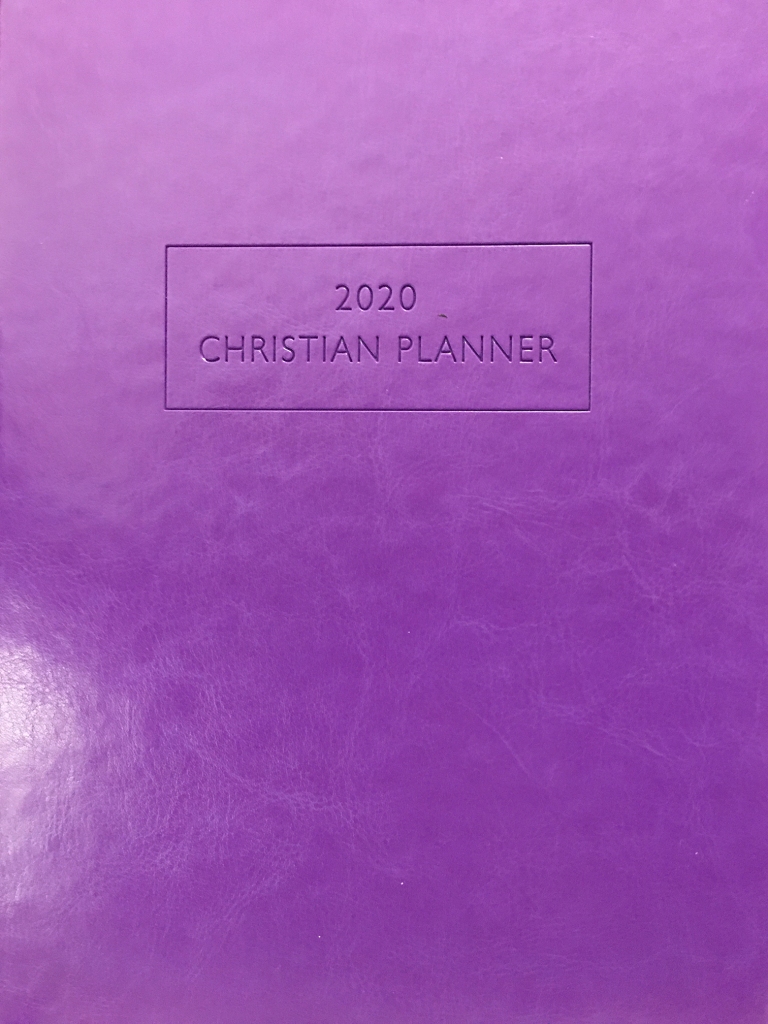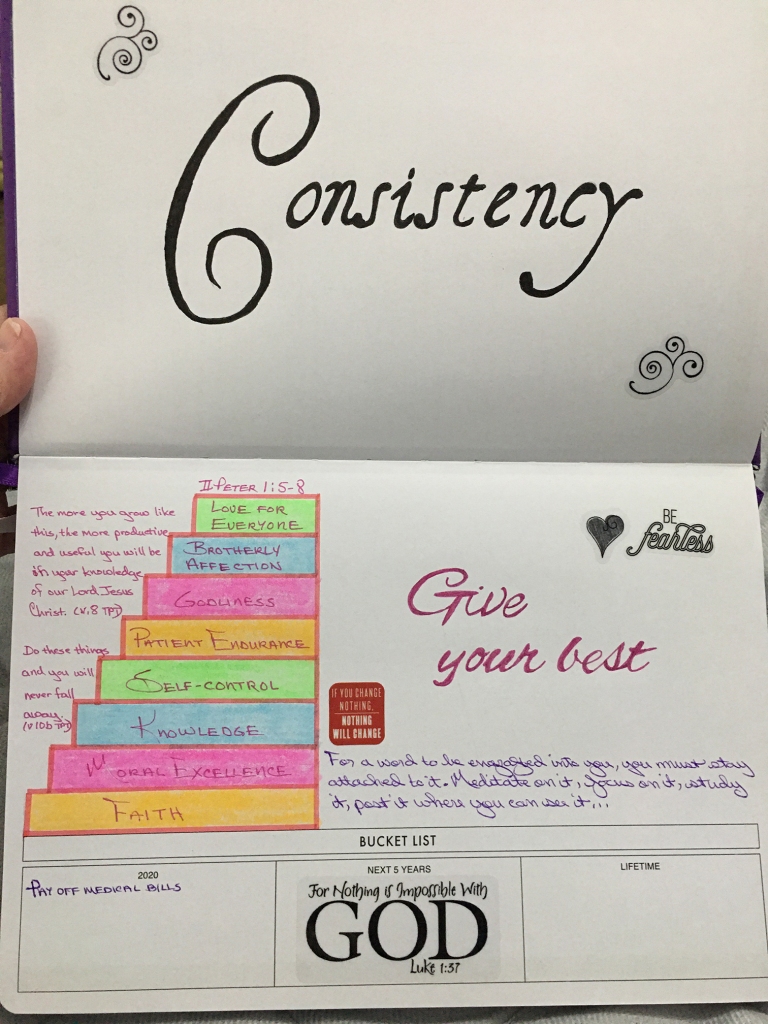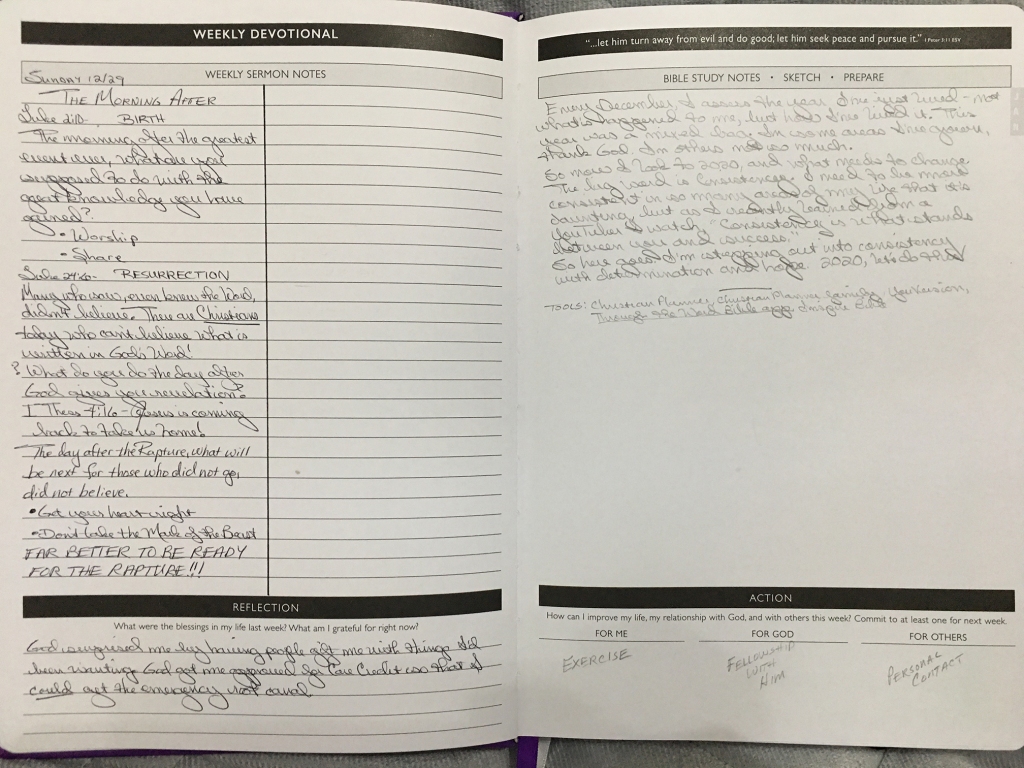
Consistency doesn’t just happen; it requires deliberation, conscious action, forethought, planning… and the greater the number of areas that require work, the more your plan demands just the right tool. For me, for 2020, it appears that The Christian Planner is that tool.
I love planners and have used a wide variety of styles through the years. I have one that works great for the office, but this is the first I’ve found that seems to genuinely provide for every area of my personal life. Of course, since it does, there’s a lot to it. Are you ready?
Before I jump in, let me point out that planners are tools, not taskmasters. I’ve seen people look at this planner and be instantly overwhelmed, fearing they will use it improperly. You can’t. At least, I can’t imagine how you could. Since this will be a long review anyway, I’ll share some of how I’m currently using mine, but know that the way I use it will almost surely change as we move through time. That’s the beauty of it; as a tool, it has to do what I tell it to.
Open the (very nice) box and you discover a leather-like, hardcover book. Mine is purple, and it’s a little over 7” by 10” by 1” thick. Because of its size, some opt to keep it at home on their desks. I’m currently carrying it with me everywhere, having decided that my immediate future will be filled with larger purses.
An elastic strap holds it closed. Open the cover and one of the first pages you’ll see is the welcome page. It provides excellent suggestions for how to use the planner, but remember that this planner is all about what works for you.

The next two-page spread is your vision board, which also includes a small area for your “2020,” “Next 5 Years,” and “Lifetime” Bucket Lists. Don’t let the Vision Board intimidate you. Roughly, it’s a place for you to record your vision for the coming year – your goals, your dreams, etc. In my case, it’s super simple and non-traditional. God told me that my word for the year is “Consistency,” so that word alone takes up nearly half the space. The other half is a reminder of specific things I’m working on as I grow in Him. I’ve hardly even touched the Bucket List.
Flip another page and you find two charts, which I’m only just beginning to fill in. These are your Healthy Habit Goals, things you plan to focus on “Daily/Often,” “1-3 Times a Week,” “1-3 Times a Month,” and “1-3 Times a Year,” as well as your “2020 Goals.” Habakkuk told us to record the vision…or was it God who told him? Regardless, you are more likely to accomplish a goal when you record it and keep it in front of you. So, here they are.
2020 and 2021 Yearly Calendars, with holidays listed, are on the next two-page spread, and then you get to your two-page January 2020 calendar. The calendar set-up is pretty basic, but I like it. The week starts on Sunday, and there’s a column to the left of the calendar. A lot of people decorate this column, which is great, but I use it for my monthly To-Do list and clarification of calendar notes. Also on this page, you have areas set aside for…
Reflection: What blessings came into my life last month? What accomplishments am I proud of?
Action: How can I demonstrate my love for God and for others this month?
For January, my action includes a poem I read recently that particularly convicted me, and encourages me to stay open and sensitive to the needs of those around me.
Still with me? It’s about to get GOOD! Everything from here until the back of the book is repeated for every week of the year.

Next is two of my favorite pages: The Weekly Devotional Pages
The area on the left is reserved for Sermon Notes. Some people take their notes in church and then copy them over. I take my notes right there on the page. Also, since we have a midweek service. I drew a line down the center of this page so that I have two columns—one for each service’s notes.
This is one of my favorite features because, in the past, I’ve often forgotten all about the service within just a couple of days. I’ve years’ worth of sermon notebooks scattered all over, but this actually puts the notes in my hand and keeps them there all year. It gives me an open opportunity to go back over those notes repeatedly in coming week and months. It was, in truth, this that drew me to this planner.
Reflection and Action also appear here, but in reference to the past and coming week, specifically. You also have an area that is labeled “Bible Study Notes * Sketch * Prepare.” This is another area in which I deviate from the expected. One of my “consistency” goals is to write more. That being the case, my current plan calls for me using this area to write blog posts and whatever else comes to mind that week. The consistency goal, of course, is for it to never be left blank.
Now the weekly pages. Each one-week, two-pages spread consists of eight columns, the first of which many people decorate, but as is true with the monthly calendar, I use it for my To Do List. My appointments are all on the monthly calendar, and I see no need to duplicate them here. Instead, I use this as a daily record. I may record accomplishments, details of important phone calls, comments made by friends, things God spoke to me that day…whatever strikes me as being appropriate.
At the bottom of these two pages, are “My Space,” which is there for you to use in any way you choose, and the “Daily Healthy Habit Tracker.” This second one is cool. If you like checking off To Do lists as much as I do, you’ll use this. There is space to record nine different habits that you want to establish or reinforce in your life, and there are delightful little checkboxes for every day of the week under each. I’m three days into the week, and I’m already seeing clearly where I’ve made progress…and where I haven’t. You label these as you wish, and can change them every week if you like. I like.
Behind the calendars, the book ends with a dozen or so blank pages. At first, I thought I wouldn’t be using these, but after I discovered the Christian Planner Family group on Facebook, and saw how others were using their pages, I started filling them up.
To give you ideas…
Currently, I have a two-page spread showing all of the books of the Bible broken down into chapters. I highlight each chapter as I read it. Considering how often you read a chapter here and a chapter there, use this chart and you may discover that you actually read more of the Bible than you thought.
I covered the next two pages with scrapbook paper to make them stand out a little more. Here I keep post-it notes with prayer requests that I’m currently focusing on. One of my “consistency” items is to be more focused about interceding on behalf of others; that’s where this part of the tool comes into play.
A hand-drawn bookcase follows. As I read non-Bible books through the year, I will record their titles on the book spines in this drawing. I left the facing page blank just in case I end up reading more than I currently anticipate.
A budget spreadsheet takes up the following two pages. Yes, with such personal stuff in it I’ll be guarding this book, but I think I might finally have found a way to handle my budget that actually works for me. We shall see.
And there you are, having glimpsed one of the tools I hope will help me make the changes I want to see in me in 2020. If you’re interested in learning more, head over to The Christian Planner Family group on Facebook. It’s a wonderful community filled with Christians who support, encourage, educate, and in general focus on loving the brethren. Because it’s the group for this publisher, the focus is this planner, but you definitely don’t have to use the planner to benefit from the group.
Check it out: www.ChristianPlanner.com
The planner is priced at $34.95, and if you’d like to try it before you buy it, you can download a PDF. How cool is that?!
Be sure to tell them you learned about the planner from me. They have no clue who I am, but still…
Celebrating Jesus!
Tammy C